GP41
| Location: Yarram. | Australian Soil Classification: Sodic, Eutrophic, Grey DERMOSOL. |
| Geology: Late Pleistocene alluvial deposits. | |
| General Landscape Description: Lower slope on gently undulating plain (1-2% slope) of old prior stream landscape (stagnant alluvial plain). This site is located on the near floodplain position of a prior stream. | |
| Soil Mapping Unit: Yarram. | Site Description: Grazing paddock. |
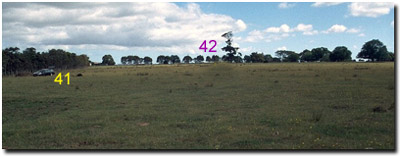 Site GP41 Landscape |
Soil Profile Morphology:
Surface Soil
| A11 | 0-25 cm | Dark greyish brown (10YR4/2); silty clay loam; moderate polyhedral structure; very firm consistence dry; pH 5.5; clear change to: | 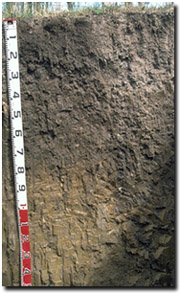 Site GP41 Profile |
| A12 | 25-50 cm | Dark greyish brown (10YR4/2) with faint yellowish brown (10YR5/8) mottles and some bleached material; heavy silty clay loam; strong coarse blocky structure; strong consistence dry; pH 5.8; clear change to: | |
| Subsoil | |||
| B21 | 50-75 cm | Dark greyish brown (10YR4/2) with yellowish brown (10YR5/8) mottles as well as bleached material down some root channels; medium clay; moderate coarse prismatic, parting to strong medium polyhedral structure; strong consistence dry; pH 5.9; gradual and wavy change to: | |
| B22 | 75-100 cm | Grey (10YR6/1) with brownish yellow (10YR6/8) mottles; heavy clay; contains few (5%) manganese and iron nodules; pH 6.1; gradual change to: | |
| B23 | 100-150 cm | Heavy clay; coarse prismatic structure; contains few (2-10%) manganese stains; pH 5.9. | |
Key Profile Features:
- Moderate texture contrast between surface (A) and subsoil (B) horizons.
pH | Salinity Rating | |||
Surface (A11 horizon) | Strongly Acid | Low | Non-Sodic | None1 |
Subsoil (B21 horizon) | Moderately Acid | Very low | Sodic | Moderate2 |
Deeper subsoil (at 1 m) | Moderately Acid | Low | Sodic | Moderate2 |
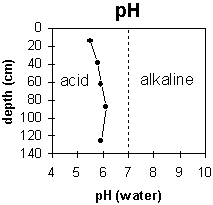 | 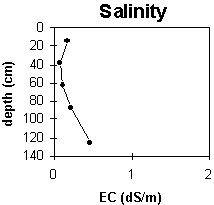 | 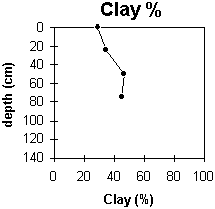 |
The surface soil is strongly acid. The subsoil is moderately acid throughout. | The salinity rating is low throughout the profile. | There is only a moderate increase in clay percentage at the A/B horizon interface. |
Horizon | Horizon Depth (cm) | pH (water) | pH (CaCl2) | EC 1:5 | NaCl | Exchangeable Cations | |||
Ca | Mg | K | Na | ||||||
meq/100g | |||||||||
A11 | 0-25 | 5.5 | 4.8 | 0.17 | 5.3 | 4.4 | 0.6 | 0.72 | |
A12 | 25-50 | 5.8 | 4.7 | 0.07 | 3.4 | 4.3 | 0.23 | 0.7 | |
B21 | 50-75 | 5.9 | 4.8 | 0.11 | 3.5 | 6.2 | 0.27 | 1.5 | |
B22 | 75-100 | 6.1 | 6.1 | 0.22 | 3.4 | 6.3 | 0.29 | 2.1 | |
B23 | 100-150 | 5.9 | 5.2 | 0.47 | 0.12 | ||||
Horizon | Horizon Depth (cm) | Exchangeable Aluminium mg/kg | Exchangeable Acidity meq/100g | Field Capacity pF2.5 | Wilting Point pF4.2 | Coarse Sand (0.2-2.0 mm) | Fine Sand (0.02-0.2 mm) | Silt (0.002-0.02 mm) | Clay (<0.002 mm) |
A11 | 0-25 | <10 | 15 | 19.1 | 2 | 20 | 40 | 29 | |
A12 | 25-50 | 9.7 | 15.7 | 2 | 21 | 41 | 34 | ||
B21 | 50-75 | 11 | 18.6 | 1 | 18 | 34 | 46 | ||
B22 | 75-100 | 7 | 17.9 | 3 | 19 | 32 | 45 | ||
B23 | 100-150 |
Management Considerations:
Whole Profile
- The soil profile is moderately to strongly acid. As a result, deficiencies in molybdenum, potassium and phosphorus may occur. Manganese toxicity may also occur in strongly acid soils, particularly when poorly drained (as waterlogging may bring manganese into solution). Soils in these low-lying positions are likely to suffer from seasonal waterlogging.
- Plant available water capacity (PAWC) is considered to be low-moderate (estimated at 95 mm) for the top metre of the soil profile. This is based on available laboratory data. A significant proportion of the plant available water is held in the surface (A) horizons. PAWC has been estimated here using a model developed by Littleboy (1995) which uses analytical data for clay %, fine sand %, silt %, coarse sand % and wilting point value.
- The surface (A1) horizon is strongly acid which indicates that aluminium toxicity may occur. However, exchangeable aluminium levels measured at this site are not high (i.e. <10 mg/kg). A pH/aluminium test sampled across the paddock would be appropriate to determine whether lime is needed to raise soil pH. Other factors need to be considered before lime is recommended (e.g. pasture species grown, method of application, local trial responses, soil surface structure and likely cost/benefit).
- Deficiencies in molybdenum and phosphorus are likely to occur in strongly acid soils. If lime is required, an application may assist in alleviating molybdenum deficiency and will increase phosphorus availability, as well as increasing soil pH.
- The surface (A1) horizon has a high silt and fine sand content (60%) and therefore the soil will rely to a large extent on organic matter to maintain aggregation and prevent slaking.
- The inherent fertility of the surface (A1) horizon (based on the sum of the exchangeable basic cations) is moderate. The organic matter and total nitrogen levels are also reasonably high.
- The subsoil is non-sodic but disperses slightly after remoulding. This indicates that disturbance (e.g. by tillage) to this horizon whilst in a moist to wet condition may result in some structural degradation.
- The coarsely structured and dense subsoil is sodic (and has a low exchangeable calcium to magnesium ratio) and moderate dispersion is evident. This will result in restricted root and water movement in the subsoil. Waterlogging of the surface horizons above (verified by the presence of bleached material) is likely to occur after heavy rains. Subsoil dispersion results in restricted root and water movement as dispersed clay blocks pore spaces.
- The subsoil has a low to moderate inherent fertility throughout (based on the sum of the exchangeable basic cations). The cations are dominated by exchangeable magnesium which may create nutrient imbalances. For example, high levels of exchangeable magnesium may result in potassium deficiencies in some soils (Baker and Eldershaw 1993).


